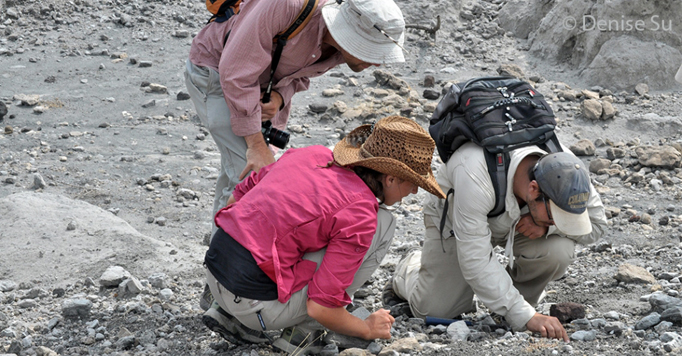
Laetoli is a Pliocene (about 3.5 million-3.8 million years ago) site in the Ngorongoro Conservation Area of northern Tanzania, located about 870 km (540 miles) northwest of Dar es Salaam and about 32 km (20 miles) southwest of Olduvai Gorge.
It is best known for the Laetoli Footprints, a 27 meter (88 feet) trail of 70 fossilized footprints believed to have been made
Australopithecus afarensis – the species of early human ancestor to which “Lucy” belongs.
Since 2000, Dr. Denise Su has been part of a multinational,
multidisciplinary team led by Terry Harrison, Professor of Anthropology at New York University. The primary focus of the project since it began in 1998 is finding and studying fossil remains of early humans, animals and plants that will provide more insight about
Au. afarensis and the environment in which early human ancestors lived. To date, the site has yielded more than 10,000 fossil specimens, including several of
Au. afarensis.

Getting ready for the field
Packing the Land Cruisers with all of our field supplies.

On our way
Driving to Laetoli in our fully loaded Land Cruisers.

On our way
A look inside one of the Land Cruisers, packed with supplies and people!

On our way
Almost there, driving through Endulen, the closest village to Laetoli.

Arriving at the Laetoli campsite
After 2 days of driving, we finally arrive at the Laetoli campsite late in the afternoon.

Arriving at the Laetoli campsite
First things first, unload all of the Land Cruisers!

Setting up the campsite
First, the kitchen crates are unpacked and the food tent is set up.

Setting up the campsite
As soon as the food crates are open, our cook gets started preparing dinner.

Setting up the campsite
Second, personal sleeping tents get put up.

Setting up the campsite
Third, the shower enclosure is set up.

Setting up the campsite
Third, the 'cho' or toilet area is set up for some privacy.

Setting up the campsite
Lastly, but very importantly, a canopy is rigged so that we can have some shade while cleaning fossils, cataloging and eating.

The finished campsite
After 2 days of hard work, the campsite is completely set up. Now, we can start looking for fossils!

The first sunrise we see at Laetoli.

Looking for fossils
Most of the time, we are looking for fossils on the surface of the ground that have been uncovered by erosional processes, such as wind and rain.

Looking for fossils

Looking for fossils

Looking for fossils
We often encounter the local people, the Masai, while out looking for fossils. They are always very curious about what we are doing.

Looking for fossils
We also encounter a lot of wildlife while looking for fossils. After all, we are in the Ngorongoro Game Reserve.

Looking for fossils
GPS coordinates are recorded for each locality and certain fossils, such as specimens of hominins.

Looking for fossils
Tom Rein finds a hominin jaw fragment!

Looking for fossils
Terry Harrison carefully excavating the hominin jaw fragment.

Looking for fossils
The scraped sediments are sieved to make sure that no hominin bones are missed.

Fossils in the field
A chunk of exposed twigs and branches.

Fossils in the field
Bee brood cells and cocoons.

Fossils in the field
A skeleton of a rabbit that is just eroding out of the ground.

Fossils in the field

Fossils in the field
Fossilized footprints of dik-diks, birds, rabbits.

Fossils in the field
A close-up of the footprint trails.

Fossils in the field
A just exposed bovid humerus (one of the bones in the forelimb).

After fossil collection
Putting all of the fossils collected during the day on the table to prepare for prepping and cataloging.

After fossil collection
Some of the fossils collected that day.

After fossil collection
Cleaning and putting together broken pieces of fossils that belong to a rabbit skeleton.

After fossil collection
Cleaning the matrix from a fossil specimen.

After fossil collection
Identifying a rodent jaw.

After fossil collection
We are finally ready to catalog the fossils! Information including locality and identification are recorded for each specimen.

A beautiful sunset at Laetoli to end the day.

In the lab
Fossil specimens from the season are organized and sorted before going into trays for storage at the National Museum of Tanzania.

In the lab
Fossil specimens from the season are organized and sorted before going into trays for storage at the National Museum of Tanzania.

In the lab
Specimen identifications are refined and measurements are taken for further analyses.
-
-
Relevant publications
Su, D. F. 2012.
What is it Like to be a Biological Anthropologist? A Field Paleontologist's Point of View. Nature Education Knowledge 3(6)
Su, D. F. 2011.
Large Mammal Evidence for the Paleoenvironment of the Upper Laetolil and Upper Ndolanya Beds, Laetoli, Tanzania. In (T. Harrison, ed) Paleontology and Geology of Laetoli: Geology, Geochronology, Paleoenvironment, and Paleoecology. pp. 381-392. Springer
.
Su, D. F. and Harrison, T. 2008.
Ecological implications of the relative rarity of fossil hominins at Laetoli. Journal of Human Evolution, 55: 672-681.